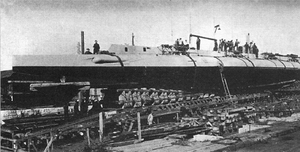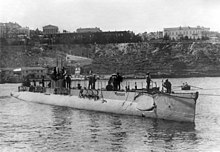| This article includes a list of general references, but it lacks sufficient corresponding inline citations. Please help to improve this article by introducing more precise citations. (February 2013) (Learn how and when to remove this message) |
 Russian submarine Narval under construction Russian submarine Narval under construction
| |
| Class overview | |
|---|---|
| Name | Narval class |
| Builders | Nikolayev Dockyard |
| Operators | |
| In commission | 1914–1919 |
| Completed | 3 |
| Lost | 3 |
| General characteristics | |
| Type | Submarine |
| Displacement |
|
| Length | 70.1 m (230.0 ft) |
| Beam | 6.5 m (21.3 ft) |
| Draught | 3.5 m (11.5 ft) |
| Installed power |
|
| Propulsion |
|
| Speed |
|
| Range |
|
| Complement | 47 |
| Armament |
|
The Narval class were a group of submarines built for the Imperial Russian Navy. They were designed by the Electric Boat Company and ordered in the 1911 programme as the "Holland 31A" design (the Electric Boat company designation was EB31A). The Narval class had advanced features including watertight bulkheads, a crash diving tank and gravitationally filled ballast tanks which did not feature in contemporary Russian-designed boats. The boats were well regarded by the Russian Navy and served in the Black Sea Fleet during World War I, during which they sank 8 merchant ships and 74 coastal vessels.
At the end of 1917, the submarines were transferred to the reserve. The submarines were scuttled by British forces in April 1919 near Sevastopol.
Ships
Three submarines were built by Nikolayev Dockyard.
| Name | Cyrillic | Meaning | Launched | Fate |
|---|---|---|---|---|
| Narval | Нарвал | Narwhal | 11 April 1915 | Scuttled in Sevastopol 26 April 1919 |
| Kit | Кит | Whale | May 1915 | Scuttled in Sevastopol 26 April 1919 |
| Kashalot | Кашалот | Sperm whale | 22 August 1915 | Scuttled in Sevastopol 26 April 1919 |
Kit was raised by EPRON in 1934, but the hulls of the other two boats remain on the bottom in the place they were scuttled. The whereabouts of Narval was unknown until October 2014, though some historians believe it was virtually discovered by the Soviet underwater laboratory Bentos-300 back in 1980. In June 2018, a joint expedition of the Russian Geographical Society's Sevastopol branch, the Ministry of Defence and Sevastopol State University was undertaken to examine the wreck of five submarines, including Narval and Kashalot, by using a remotely operated underwater vehicle. It was reported in May 2019 that the wreck site is to be listed as a cultural heritage.

References
- Friedman, pp. 88. "Holland 31A" was likely the Russian Navy designation. Submarines built by EB were colloquially known as "Holland types" in other navies.
- Gulenko, Sergey (18 October 2014). "Моряки ЧФ РФ нашли под Севастополем субмарину времен Первой мировой войны". Komsomolskaya Pravda (in Russian). Retrieved 2019-09-16.
- Savchenko, Nikolay (23 October 2014). "Век под водой". Rossiyskaya Gazeta (in Russian). No. 6515. Retrieved 2019-09-16.
- Krymskaya, Yulia (28 June 2018). "У Севастополя ученые обследовали затопленные царские подлодки". Rossiyskaya Gazeta (in Russian). Retrieved 2019-09-16.
- "Эксперт: найденные под Севастополем первые русские подлодки станут культурными объектами" (in Russian). TASS. 13 May 2019. Retrieved 2019-09-16.
Further reading
- Friedman, Norman, US Submarines through 1945: An Illustrated Design History, Annapolis: Naval Institute Press, 1995, ISBN 1-55750-263-3.
- Gardiner, Robert, ed. (1985). Conway's All the World's Fighting Ships 1906–1921. Naval Institute Press. ISBN 978-0-87021-907-8. Retrieved 13 August 2011.
- "Тип "Нарвал" (проект "Голланд-31А" (Holland-XXXIA), США)" [Narval class (project "Holland-31A" (Holland-XXXIA), USA)]. deepstorm.ru (in Russian). Retrieved 2011-08-13.
- Zablocki V.P. Submarines "Narwhal". Marine Collection 12/2011.
| Russian naval ship classes of World War I | |
|---|---|
| Dreadnought battleships | |
| Pre-dreadnought battleships | |
| Battlecruisers | |
| Armored cruisers | |
| Light cruisers | |
| Protected cruisers | |
| Destroyers | |
| Torpedo boats | |
| Submarines | |
| |